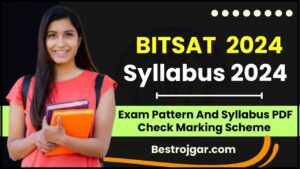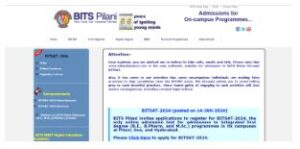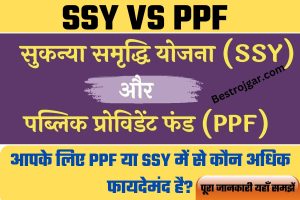BITSAT Syllabus 2024: बिटसैट परीक्षा पैटर्न और सिलेबस पीडीएफ, चेक मार्किंग स्कीम जाने पूरी जानकारी हमारे बेवसाइट पर
BITSAT Syllabus 2024: BITSAT 2024 का पूरा सिलेबस यहां उपलब्ध कराया गया है। प्रवेश परीक्षा एक सत्र में दो बार आयोजित की जाएगी, पहला सत्र मई में और दूसरा सत्र जून 2024 में। प्रवेश परीक्षा के लिए आवेदन करने वाले उम्मीदवार विस्तृत बिटसैट पाठ्यक्रम और परीक्षा पैटर्न की जांच कर सकते हैं। BITSAT Syllabus
BITSAT Syllabus 2024 के According to English, Mathematics, Physics, Chemistry and Logical Reasoning से 130 प्रश्न होंगे। उम्मीदवारों को 3 घंटे में इन प्रश्नों का प्रयास करना होगा। BITSAT Syllabus

BITSAT Syllabus 2024 – Highlights
| Exam Full Name | Birla Institute of Technology and Science Admission Test |
| Conducting Body | Birla Institute Of Technology And Science (BITS Pilani) |
| Frequency of conduct | Twice a year |
| Exam Level | University-based National Exam Level |
| Languages | English |
| BITSAT Exam Date |
|
BITSAT Syllabus Exam Pattern 2024
- Duration: 3 hours
- There will be four parts
- Part I: Physics
- Part II: Chemistry
- Part III: (a) English Proficiency and (b) Logical Reasoning
- Part IV: Mathematics or Biology (For B. Pharm. candidates)
- All questions are of objective type (multiple choice questions);
- Each question with a choice of four and only one will be correct
- Each correct answer awards 3 marks,
- While each incorrect response will have a penalty of -1 marks
BITSAT Syllabus Exam Pattern 2024
| Part | Section | Number of Questions | Total Marks |
| I | Physics | 30 | 90 |
| II | Chemistry | 30 | 90 |
| III | English Proficiency | 10 | 30 |
| Logical Reasoning | 20 | 60 | |
| IV | Mathematics/ Biology | 40 | 120 |
| Total | 130 | 390 | |
Extra 12 Questions!
यदि कोई व्यक्ति बिना स्किप किए सभी प्रश्नों का उत्तर देता है और अभी भी समय बचा है तो भौतिकी, रसायन विज्ञान, गणित और तार्किक तर्क (प्रत्येक से 3 प्रश्न) से प्रश्नों के 12 अतिरिक्त सेट उनकी स्क्रीन पर दिखाई देंगे।

BITSAT Syllabus 2024
प्रश्नों का स्तर कक्षा 11 वीं और 12 वीं NCERT पाठ्यक्रम पर आधारित होगा। उम्मीदवार आधिकारिक वेबसाइट पर उम्मीदवारों के लिए उपलब्ध कराए गए नमूना परीक्षण की जांच कर सकते हैं। यहां उम्मीदवार BITSAT Syllabus 2024 के लिए विषयों और उप-विषयों की जांच कर सकते हैं।
BITSAT Physics Syllabus
| Topics | Sub Topics of BITSAT Syllabus |
| Units and Measurement | Units |
| Dimensional Analysis | |
| Precision and significant figures | |
| Fundamental Measurements in Physics | |
| Kinematics | Properties of vectors |
| Position, velocity, and acceleration vectors | |
| Motion with constant acceleration | |
| Projectile motion | |
| Uniform circular motion | |
| Relative motion | |
| Newton’s Laws of Motion | Newton’s laws |
| Motion on an inclined plane | |
| Motion of blocks with pulley systems | |
| Circular motion – centripetal force | |
| Inertial and non-inertial frames | |
| Impulse and Momentum | Definition of impulse and momentum |
| Conservation of momentum | |
| Collisions | |
| Momentum of a system of particles | |
| Center of mass | |
| Work and Energy | Work done by a force |
| Kinetic energy and work-energy theorem | |
| Power | |
| Conservative forces and potential energy | |
| Conservation of mechanical energy | |
| Rotational Motion | Description of rotation |
| Rotational motion with constant angular acceleration | |
| Moment of inertia, Parallel, and perpendicular axes theorems, rotational kinetic energy | |
| Torque and angular momentum | |
| Conservation of angular momentum | |
| Rolling motion | |
| Gravitation | Newton’s law of gravitation |
| Gravitational potential energy, Escape velocity | |
| Motion of planets – Kepler’s laws, satellite motion | |
| Mechanics of Solids and Fluids | Elasticity |
| Pressure, density and Archimedes’ principle | |
| Viscosity and Surface Tension | |
| Bernoulli’s theorem | |
| Oscillations | Kinematics of simple harmonic motion |
| Spring mass system, simple and compound pendulum | |
| Forced and damped oscillations, resonance | |
| Waves | Progressive sinusoidal waves |
| Standing waves in strings and pipes | |
| Superposition of waves, beats | |
| Doppler Effect | |
| Heat and Thermodynamics | Kinetic theory of gases |
| Thermal equilibrium and temperature | |
| Specific heat, Heat Transfer | |
| Work, heat, and first law of Thermodynamics | |
| 2nd law of thermodynamics | |
| Electrostatics | Coulomb’s law |
| Electric field | |
| Electrostatic potential and Electrostatic potential energy | |
| Gauss’ law and its applications | |
| Electric dipole | |
| Capacitance and dielectrics | |
| Current Electricity | Ohm’s law, Joule heating |
| D.C circuits | |
| Electrical Resistance | |
| Magnetic Effect of Current | Biot-Savart’s law and its applications |
| Ampere’s law and its applications | |
| Lorentz force, force on current-carrying conductors in a magnetic field | |
| Magnetic moment of a current loop, torque on a current loop, Galvanometer and its conversion to voltmeter and ammeter | |
| Electromagnetic Induction | Faraday’s law, Lenz’s law, eddy currents |
| Self and mutual inductance | |
| Transformers and generators | |
| Alternating current | |
| AC circuits, LCR circuits | |
| Optics | Laws of reflection and refraction |
| Lenses and mirrors | |
| Optical instruments – telescope and microscope | |
| Interference – Huygens principle, Young’s double-slit experiment | |
| Interference in thin films | |
| Diffraction due to a single slit | |
| Electromagnetic waves and their characteristics, Electromagnetic spectrum | |
| Polarization | |
| Modern Physics | Dual nature of light and matter |
| Atomic models | |
| Hydrogen atom spectrum | |
| Radioactivity | |
| Nuclear reactions: Fission and fusion, binding energy | |
| Electronic Devices | Energy bands in solids, conductors, insulators and semiconductors; |
| Semiconductor diode, Zener diode | |
| Junction transistor, transistor action, characteristics of a transistor; transistor as an amplifier and oscillator | |
| Logic gates. Transistor as a switch. |
BITSAT Chemistry Syllabus
| Topics | Sub Topics of BITSAT Syllabus |
| 1. States of Matter | 1.1 Measurement |
| 1.2 Chemical reactions | |
| 1.3 Three states of matter | |
| 1.4 Liquid state | |
| 1.5 Solid state | |
| 2. Atomic Structure | 2.1 Introduction |
| 2.2 Quantum mechanics | |
| 2.3 Many electron atoms | |
| 2.4 Periodicity | |
| 3. Chemical Bonding and Molecular Structure | 3.1 Valence electrons, Ionic Bond |
| 3.2 Molecular Structure | |
| 3.3 Covalent Bond | |
| 3.4 Dipole moments; Hydrogen Bond. | |
| 4. Thermodynamics | 4.1 Basic Concepts |
| 4.2 First Law of Thermodynamics | |
| 4.3 Second Law | |
| 4.4 Third Law | |
| 5. Physical and Chemical Equilibria | 5.1 Concentration Units |
| 5.2 Solutions | |
| 5.3 Physical Equilibrium | |
| 5.4 Chemical Equilibria | |
| 5.5 Ionic Equilibria | |
| 5.6 Factors Affecting Equilibria | |
| 6. Electrochemistry | 6.1 Redox Reactions |
| 6.2 Electrolytic Conduction | |
| 7. Chemical Kinetics | 7.1 Aspects of Kinetics |
| 7.2 Factors Affecting the Rate of the Reactions | |
| 7.3 Surface Chemistry | |
| 8. Hydrogen and s-block elements | 8.1 Hydrogen |
| 8.2 s-block elements | |
| 8.3 Alkali metals | |
| 9. p- d- and f-block elements | 8.4 Alkaline earth metals |
| 9.1 General | |
| 9.2 Group 13 elements | |
| 9.3 Group 14 elements | |
| 9.4 Group 15 elements | |
| 9.5 Group 16 elements | |
| 9.6 Group 17 and group 18 elements | |
| 9.7 d-Block elements | |
| 9.8 f-Block elements | |
| 9.9 Coordination Compounds | |
| 10. Principles of Organic Chemistry and Hydrocarbons | 10.1 Classification |
| 10.2 Electronic displacement in a covalent bond | |
| 10.3 Alkanes | |
| 10.4 Alkenes and alkynes | |
| 10.5 Aromatic hydrocarbons | |
| 10.6 Haloalkanes and Haloarenes | |
| 11. Stereochemistry | 11.1 Conformations |
| 11.2 Geometrical isomerism in alkenes | |
| 12. Organic Compounds with Functional Groups Containing Oxygen and Nitrogen | 12.1 General |
| 12.2 Specific | |
| 13. Biological, Industrial and Environmental chemistry | 13.1 Carbohydrates |
| 13.2 Proteins | |
| 13.3 Nucleic Acids | |
| 13.4 Vitamins | |
| 13.5 Polymers. | |
| 13.6 Pollution | |
| 13.7 Chemicals in medicine, health care and food | |
| 14. Theoretical Principles of Experimental Chemistry | 14.1 Volumetric Analysis |
| 14.2 Qualitative Analysis of Inorganic Salts | |
| 14.3 Physical Chemistry Experiments | |
| 14.4 Purification Methods | |
| 14.5 Qualitative Analysis of Organic Compounds | |
| 14.6 Quantitative Analysis of Organic Compounds | |
| 14.7 Principles of Organic Chemistry Experiments | |
| 14.8 Basic Laboratory Technique |
BITSAT Math Syllabus
- Algebra
1.1 Complex numbers.
1.2 Quadratic equations
1.3 Arithmetic and geometric progressions,
1.4 Logarithms and their properties.
1.5 Exponential series.
1.6 Permutations and combinations.
1.7 Binomial theorem, Pascal’s triangle
1.8 Matrices and determinants.
1.9 Sets, Relations and Functions,
1.10 Mathematical Reasoning and Methods of Proof
1.11 Linear Inequalities
- Trigonometry
2.1 Measurement of angles in radians and degrees,
2.2 Solution of trigonometric equations.
2.3 Inverse trigonometric functions
- Two-dimensional Coordinate Geometry
3.1 Cartesian coordinates, the distance between two points, section formulae, shift of origin.
3.2 Straight lines and pair of straight lines
3.3 Circles
3.4 Conic sections
- Three-dimensional Coordinate Geometry
4.1 Coordinate axes and coordinate planes, the distance between two points, section formula, direction cosines, and direction ratios, equation of a straight line in space, and skew lines.
4.2 Angle between two lines whose direction ratios are given, the shortest distance between two lines.
4.3 Equation of a plane, distance of a point from a plane, condition for coplanarity of three lines, angles between two planes, angle between a line and a plane.
- Differential calculus
5.1 Domain and range of a real-valued function, Limits and Continuity of the sum, difference, product, and quotient of two functions, Differentiability.
5.2 Derivative of different types of functions, derivative of the sum, difference, product, and quotient of two functions, chain rule, parametric form.
5.3 Geometric interpretation of derivative, Tangents, and Normals
5.4 Increasing and decreasing functions, Maxima, and minima of a function.
5.5 Rolle’s Theorem, Mean Value Theorem, and Intermediate Value Theorem
- Integral calculus
6.1 Integration is the inverse process of differentiation, indefinite integrals of standard functions.
6.2 Methods of integration: Integration by substitution, Integration by parts, integration by partial fractions, and integration by trigonometric identities.
6.3 Definite integrals and their properties, Fundamental Theorem of Integral Calculus, applications in finding areas under simple curves.
6.4 Application of definite integrals to the determination of areas of regions bounded by simple curves
- Ordinary Differential Equations
7.1 Order and degree of a differential equation, formulation of a differential equation whole general solution is given, variables separable method.
7.2 Solution of homogeneous differential equations of first-order and first-degree
7.3 Linear first-order differential equations
- Probability
8.1 Various terminology in probability, axiomatic and other approaches of probability, addition and multiplication rules of probability
8.2 Conditional probability, total probability and Baye’s theorem
8.3 Independent events
8.4 Discrete random variables and distributions with mean and variance.
- Vectors
9.1 Direction ratio/cosines of vectors, addition of vectors, scalar multiplication, position vector of a point dividing a line segment in a given ratio.
9.2 Dot and cross products of two vectors, projection of a vector on a line.
9.3 Scalar triple products and their geometrical interpretations.
- Statistics
10.1 Measures of dispersion
10.2 Analysis of frequency distributions with equal means but different variances
- Linear Programming
11.1 Various terminology and formulation of Linear Programming
11.2 Solution of linear Programming using graphical method, feasible and infeasible regions, feasible and infeasible solutions, optimal feasible solutions (up to three non-trivial constraints)
- Mathematical modeling
12.1 Formulation of simple real-life problems, solutions using matrices, calculus and linear programming.
BITSAT Logical Reasoning Syllabus
| Verbal Reasoning |
|
| Non-Verbal Reasoning |
|
BITSAT English Syllabus
- Grammar
1.1 Determiners, Prepositions, Modals, Adjectives, Relative Pronouns
1.2 Agreement, Time and Tense
1.3 Parallel Construction
1.4 Voice, Transformation
1.5 Question Tags, Relative Clauses
- Vocabulary
2.1 Odd Word, One Word, Spelling & Word Formation, Homophones
2.2 Contextual Meanings of Vocabulary
2.3 Synonyms, Antonyms, Collocations
2.4 Phrasal Verbs & Idioms
2.5 Analogy
- Reading Comprehension
3.1 Content/Ideas
3.2 Vocabulary
3.3 Summary
3.4 Referents
3.5 Reorganization of Information (Jigsaw Reading)
- Composition
4.1 Rearrangement
4.2 Paragraph & Unity
4.3 Linkers/Connectives
BITSAT Syllabus 2024: Important Links
| BITSAT Syllabus and Brochure 2024 | Click Here |
| BITSAT Notification | Click Here |
| BITSAT Official Website | Click Here |
Important Link:-
| Home Page | Click Here |
| Join Telegram | Click Here |
निष्कर्ष –BITSAT Syllabus 2024
इस तरह से आप अपना BITSAT Syllabus 2024 से संबंधित और भी कोई जानकारी चाहिए तो हमें कमेंट करके पूछ सकते हैं |
दोस्तों यह थी आज की BITSAT Syllabus 2024 के बारें में सम्पूर्ण जानकारी इस पोस्ट में आपको इसकी सम्पूर्ण जानकारी बताने कोशिश की गयी है
ताकि आपके BITSAT Syllabus 2024 से जुडी जितने भी सारे सवालो है, उन सारे सवालो का जवाब इस आर्टिकल में मिल सके|
तो दोस्तों कैसी लगी आज की यह जानकारी, आप हमें Comment box में बताना ना भूले, और यदि इस आर्टिकल से जुडी आपके पास कोई सवाल या किसी प्रकार का सुझाव हो तो हमें जरुर बताएं |
और इस पोस्ट से मिलने वाली जानकारी अपने दोस्तों के साथ भी Social Media Sites जैसे- Facebook, twitter पर ज़रुर शेयर करें |
ताकि उन लोगो तक भी यह जानकारी पहुच सके जिन्हें BITSAT Syllabus 2024 की जानकारी का लाभ उन्हें भी मिल सके|
Source:- Internet


